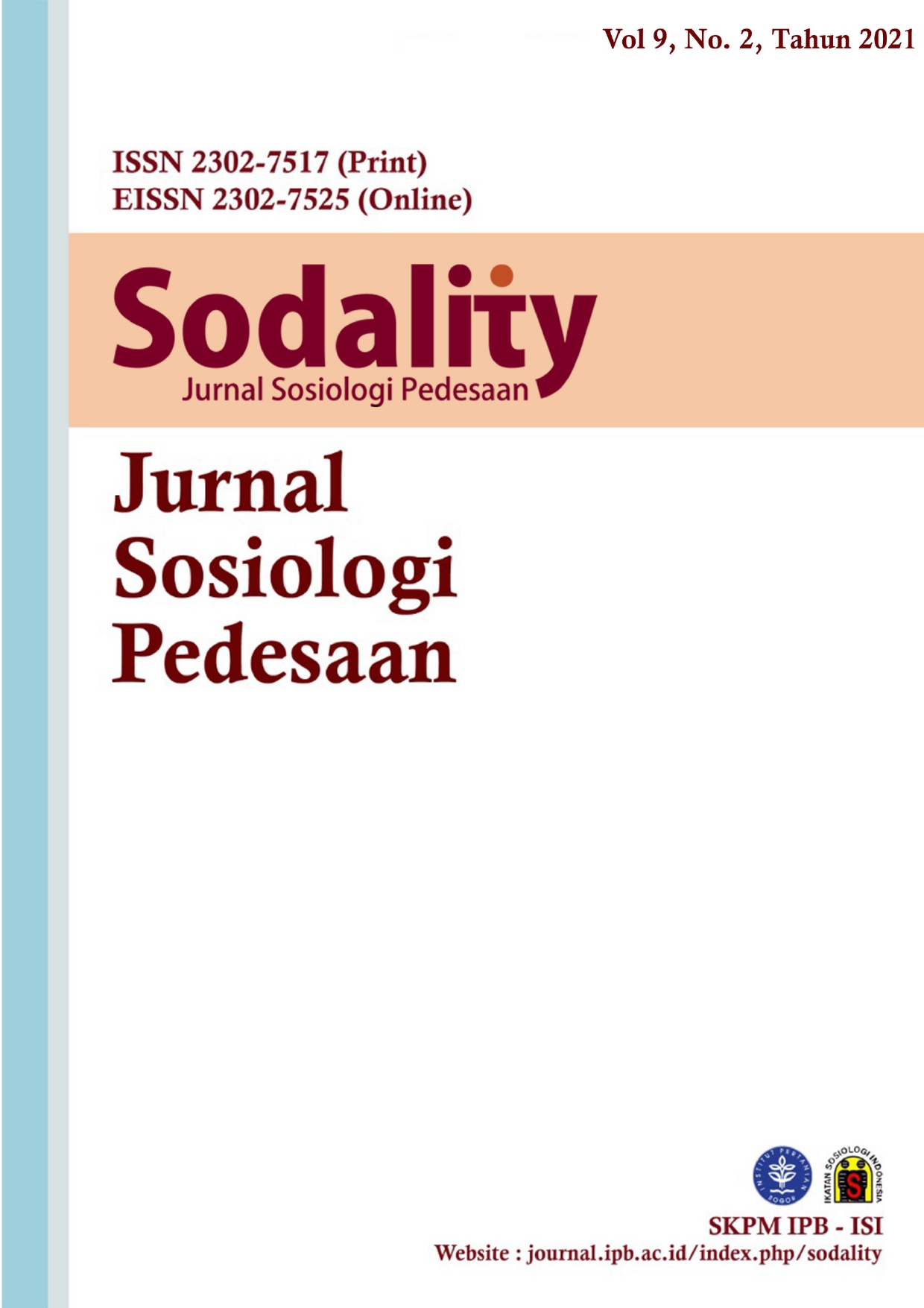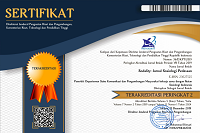The Dilemma of Agricultural Mechanization and the Marginalization of Women Farmworkers in Rural Areas
Abstract
Agricultural mechanization is one of the efforts to accelerate agricultural development through technological changes in agriculture. However, mechanization replaced human labor. The development of agricultural equipment and machinery technology (= Alsintan), which produces agricultural processing machines, has created a new role that replaces agricultural laborers' position. Women farmworkers are the most disadvantaged by mechanization. This study used a qualitative research method with a case study in Gadingsari Village, Bantul. This study shows that agricultural mechanization in Gadingsari Village has shifted the working mechanism of agriculture, to cultivate rice fields from human power to Alsintan, such as tractors, grinding machines, and threshing machines. Apart from leaving the traditional agricultural processing system, this change directly affects female agricultural laborers' employment opportunities because machinery has replaced the job and because men operate the majority of Alsintan. Hence, the dilemma: Changes in agricultural technology accelerate agricultural development, but at the same time increasingly marginalize female agricultural laborers. In the concept of a risk society, gender-biased technology places women at risk of modernity. Consequently, reflection on these risks is needed to find ways to accelerate inclusive agricultural development and promote gender equality
References
Abdullah, Irwan. 1997. Sangkan paran gender. Pustaka Pelajar.
Akter, Sonia, Pieter Rutsaert, Joyce Luis, Nyo Me Htwe, Su Su San, Budi Raharjo, and Arlyna Pustika. 2017. “Women’s Empowerment and Gender Equity in Agriculture: A Different Perspective from Southeast Asia.” Food Policy 69:270–79. doi: 10.1016/j.foodpol.2017.05.003.
Beck, Professor Ulrich. 1992. Risk Society: Towards a New Modernity. SAGE.
Behrman, Jere R. 1978. Development, the International Economic Order, and Commodity Agreements. Addison-Wesley Publishing Company.
Boserup, Ester. 1984. Peranan Perempuan Dalam Perkembangan Ekonomi. Yayasan Obor Indonesia.
Cele, Lungelo, Ingeborg Adelfang Hodgson, Michael Boateng, and Eugene Moses. 2020. “Empowering Women through Mechanisation: Where Are the Opportunities?” Retrieved October 21, 2020 (https://www.rural21.com/english/news/detail/article/empowering-women-through-mechanisation-where-are-the-opportunities.html).
Creswell, John W. 2013. Qualitative Inquiry and Research Design: Choosing Among Five Approaches. SAGE.
Elizabeth, Roosganda. 2016. “Pemberdayaan Wanita Mendukung Strategi Gender Mainstreaming dalam Kebijakan Pembangunan Pertanian di Perdesaan.” Forum penelitian Agro Ekonomi 25(2):126–35. doi: 10.21082/fae.v25n2.2007.126-135.
FAO. 2011. “The Role of Women in Agriculture.” ESA Working Paper No 11-02 48.
Fischer, Gundula, Simon Wittich, Gabriel Malima, Gregory Sikumba, Ben Lukuyu, David Ngunga, and Jacqueline Rugalabam. 2018. “Gender and Mechanization: Exploring the Sustainability of Mechanized Forage Chopping in Tanzania.” Journal of Rural Studies 64:112–22. doi: 10.1016/j.jrurstud.2018.09.012.
Geertz, Clifford. 1983. Involusi pertanian: proses perubahan ekologi di Indonesia. Bhratara Karya Aksara.
Handaka, nFN, and Abi Prabowo. 2016. “Kebijakan Antisipatif Pengembangan Mekanisasi Pertanian.” Analisis Kebijakan Pertanian 11(1):27–44. doi: 10.21082/akp.v11n1.2013.27-44.
Hastuti, Endang Lestari. 2004. “Pemberdayaan Petani dan Kelembagaan Agribisnis Lokal dalam Perspektif Gender :” ICASERD Working Paper No.40 24.
Johnson, Nancy L., Chiara Kovarik, Ruth Meinzen-Dick, Jemimah Njuki, and Agnes Quisumbing. 2016. “Gender, Assets, and Agricultural Development: Lessons from Eight Projects.” World Development 83:295–311. doi: 10.1016/j.worlddev.2016.01.009.
Kansanga, M., P. Andersen, D. Kpienbaareh, S. Mason-Renton, K. Atuoye, Y. Sano, R. Antabe, and I. Luginaah. 2019. “Traditional Agriculture in Transition: Examining the Impacts of Agricultural Modernization on Smallholder Farming in Ghana under the New Green Revolution.” International Journal of Sustainable Development & World Ecology 26(1):11–24. doi: 10.1080/13504509.2018.1491429.
Kawarazuka, Nozomi. 2018. “Agricultural Mechanization: How Far Do Women Farmers Benefit?” CGIAR Research Program on Roots, Tubers and Bananas. Retrieved October 21, 2020 (https://www.rtb.cgiar.org/news/agricultural-mechanization-far-women-farmers-benefit/).
Kodiran, and Bambang Hudayana. 1990. Peranan wanita dalam sawah surjan. Pusat Penelitian Kependudukan, Universitas Gadjah Mada.
Kurniawan, Fuat Edi. 2015. “Mekanisasi Pertanian Dan Strategi Buruh Tani Perempuan Dalam Memenuhi Perekonomian Keluarga.” Universitas Gadjah Mada.
Kurniawan, Fuat Edi. 2018a. “Food Sovereignty and The Paradox of Agricultural Development.” Journal of Indonesian Social Sciences and Humanities 8(1):85–88. doi: 10.14203/jissh.v8i1.132.
Kurniawan, Fuat Edi. 2018b. Kedaulatan Pangan Dan Paradoks Pembangunan Pertanian. yf9xg. Center for Open Science.
Kurniawan, Fuat Edi. 2020. “Mekanisasi Pertanian Dan Nasib Buruh Tani Perempuan.” OSF Preprints.
Mahanani, Subekti. 2003. “Keadilan Agraria Bagi Perempuan Tani.” Jurnal Analisis Sosial 8(2).
Manning, Chris. 2000. “Labour Market Adjustment to Indonesia’s Economic Crisis: Context, Trends and Implications.” Bulletin of Indonesian Economic Studies 36(1):105–36. doi: 10.1080/00074910012331337803.
Mehta, C., Laxman Gite, and Abhijit Khadatkar. 2018. “Women Empowerment through Agricultural Mechanization in India.” Current Science 114. doi: 10.18520/cs/v114/i09/1934-1940.
Mellor, John W. 2017. Agricultural Development and Economic Transformation: Promoting Growth with Poverty Reduction. Springer.
Mulyono, Mulyono. 2016. “Primary Data: Direct Interview.”
Priminingtyas, Dina Novia. 2013. “Marginalisasi Perempuan Dalam Pembangunan Pertanian.” 6.
Research Institute (IFPRI), International Food Policy. 2019. Gender and Agricultural Mechanization: A Mixed-Methods Exploration of the Impacts of Multi-Crop Reaper-Harvester Service Provision in Bangladesh. 0 ed. Washington, DC: International Food Policy Research Institute.
Rola‐Rubzen, Maria Fay, Thelma Paris, Jacob Hawkins, and Bibek Sapkota. 2020. “Improving Gender Participation in Agricultural Technology Adoption in Asia: From Rhetoric to Practical Action.” Applied Economic Perspectives and Policy 42(1):113–25. doi: 10.1002/aepp.13011.
Sajogyo, and Kampto Utomo. 1973. Modernization Without Development in Rural Java.
Satyavathi, C. Tara, Ch. Bharadwaj, and P. S. Brahmanand. 2011. “Role of Farm Women in Agriculture: Lessons Learned.” Gender, Technology and Development 14(3):441–49. doi: 10.1177/097185241001400308.
Scott, James C. 1977. The Moral Economy of the Peasant: Rebellion and Subsistence in Southeast Asia. Yale University Press.
Sims, Brian, and Josef Kienzle. 2017. “Sustainable Agricultural Mechanization for Smallholders: What Is It and How Can We Implement It?” Agriculture 7(6):50. doi: 10.3390/agriculture7060050.
Suratiyah, Ken, Sunarru Samsi Hariadi, I. Ketut Sudibia, and I. Wayan Sudarta. 1991. Pembangunan pertanian dan peranan wanita di pedesaan Yogyakarta dan Bali. Pusat Penelitian Kependudukan, Universitas Gadjah Mada.
Tri, Sudaryono. 2018. “The Impact of Agricultural Machinery Equipment on Rice Farming in East Java in Effort to Scarcity of The Labor.” Eurasia: Economics & Business 7(1).
Yin, Robert K. 2009. Case Study Research: Design and Methods. SAGE.
Authors who publish with this journal agree to the following terms:
- Authors retain copyright and grant the journal right of first publication with the work simultaneously licensed under a

This work is licensed under a Creative Commons Attribution 4.0 International License. that allows others to share the work with an acknowledgement of the work's authorship and initial publication in this journal. - Authors are able to enter into separate, additional contractual arrangements for the non-exclusive distribution of the journal's published version of the work (e.g., post it to an institutional repository or publish it in a book), with an acknowledgement of its initial publication in this journal.
- Authors are permitted and encouraged to post their work online (e.g., in institutional repositories or on their website) prior to and during the submission process, as it can lead to productive exchanges, as well as earlier and greater citation of published work (See The Effect of Open Access).





.png)









